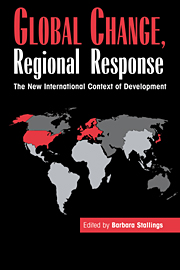Book contents
- Frontmatter
- Contents
- List of tables and figures
- List of contributors
- Acknowledgments
- Abbreviations
- 1 Introduction: global change, regional response
- Part I Global changes
- 2 The third world and the end of the cold war
- 3 Capitalisms in conflict? The United States, Europe, and Japan in the post–cold war world
- 4 Global production systems and third world development
- 5 New global financial trends: implications for development
- 6 The “triumph” of liberal economic ideas in the developing world
- Part II Regional responses
- Part III Conclusions
- Index
5 - New global financial trends: implications for development
Published online by Cambridge University Press: 05 June 2012
- Frontmatter
- Contents
- List of tables and figures
- List of contributors
- Acknowledgments
- Abbreviations
- 1 Introduction: global change, regional response
- Part I Global changes
- 2 The third world and the end of the cold war
- 3 Capitalisms in conflict? The United States, Europe, and Japan in the post–cold war world
- 4 Global production systems and third world development
- 5 New global financial trends: implications for development
- 6 The “triumph” of liberal economic ideas in the developing world
- Part II Regional responses
- Part III Conclusions
- Index
Summary
One of the most dramatic political-economic changes over the past 15 years has been the shift in patterns of international finance. At the beginning of the 1980s, a select group of prosperous third world nations had privileged access to an enormous volume of commercial bank credit. They could also attract fairly important levels of direct investment. For all practical purposes, finance was no longer a binding constraint on the development strategies of this group of countries. Although poorer developing nations could not rely on private credit or investment, many of them had access to substantial amounts of funds via bilateral donors and the international financial institutions (IFIs). The industrial world, to a much greater extent, relied on its own domestic capital markets to meet its financial requirements.
By the latter half of the 1980s, in contrast, third world countries from Latin America and Africa had become largely marginalized from global capital flows, which were increasingly circulating among industrial nations. Insofar as they were still available to developing countries, capital inflows were swamped by amortization and especially by burgeoning interest payments. Indeed, a significant number of developing countries had become capital exporters. The result was a reversal of what development theorists had traditionally argued were the appropriate roles for developed and developing economies. The former were supposed to save more than they spent and export more than they imported, while the latter were supposed to consume more than they were able to save and import more than they exported.
- Type
- Chapter
- Information
- Global Change, Regional ResponseThe New International Context of Development, pp. 143 - 173Publisher: Cambridge University PressPrint publication year: 1995
- 25
- Cited by



